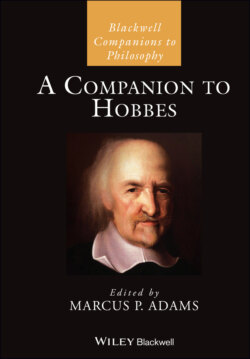Читать книгу A Companion to Hobbes - Группа авторов - Страница 50
3.2.2 The Method of Motion and Hobbes’s Geometric Ambitions
ОглавлениеPart III of De corpore bears the title “On the Proportions of Motions and Magnitudes” and contains the core geometric chapters of the treatise (namely chapters XV–XXIV). Hobbes intended these to establish his reputation as the foremost geometer in Europe. This outsized ambition is on display at the beginning of chapter XV, where he advises the attentive reader to “take into his hands the works of Euclide, Archimedes, Apollonius, and others as well Antient as Modern Writers” in order to appreciate the wealth of new results that will follow (EW I.204). He then lists 11 principles that outline the fundamental properties of motion, which are the basis for what he termed the “method of motion” that would yield straightforward solutions to all manner of geometric problems.
Hobbes’s approach is closely connected with Roberval’s method of “composition of motions,” which he employed in the solution of a wide variety of geometric problems (Julien 2015). The fundamental idea in the method can be illustrated through the comparison of the arc length of the Archimedean spiral and the semiparabola. The spiral abcdefn in Figure 3.2 arises from the uniform revolution of a point through the radius an in the same time that an completes a full revolution about the point a. The parabola GT is traced by the combination of a uniform motion through the horizontal axis GA and a uniformly accelerated motion downward to arrive at T. However, the spiral also arises from the combination of a uniform motion and a uniformly accelerated motion: as the point tracing the spiral moves through an, the revolution of the radius will make it describe portions of ever greater circular arcs and the lengths described will be as the square of the time. As a consequence, if GA is equal to the radius an and AT is equal to half the circumference of the circle with radius an, the motion producing the spiral will cover a distance equal to the length of the parabola GT.
Figure 3.2 Spiral parabola.
This result was first published in the Hydraulica of Marin Mersenne, which was part of his 1644 collection Cogitata Physico-Mathematica. Mersenne reported the discovery of the result: “when I was concerned with this result, a learned man proposed a certain straight line that he though equal to the first revolution of the spiral abcdefn, but the revolution of the spiral was greater than this proposed line, and our geometer showed that the spiral was equal to the parabola GT” (Mersenne 1644, 129). The “learned man” is Hobbes, and “our geometer” is Roberval. It is therefore clear that Hobbes was well acquainted with the method of motion in the 1640s through his contact with Roberval by way of Mersenne (Malcolm 2002).
The method of motion dominates the geometrical sections of De corpore and it is the source of the putative results with which Hobbes hoped to assert his claim to pre-eminence in geometry. The catalog of these mathematical contributions includes an analysis of parabolic arcs in the style of Galileo (chapter XVI), the quadrature of parabolic segments that builds on Cavalieri’s approach (chapter XVII), a supposed rectification of parabolic arcs (chapter XVIII) and a putative quadrature of the circle (chapter XX). Throughout these chapters Hobbes examines the motions by which geometric magnitudes are generated or transformed – comparing the uniform motion of a point in one direction with its accelerated motion orthogonal to that motion, or examining the “flexion” by which a curved arc can be straightened and compared to a given line (Dunlop 2016; Jesseph 2017).
Hobbes portrays his method of motion as a technique of analysis that went beyond what could be attained with the method of indivisibles in the style of Cavalieri or the algebraic procedures of Viète and Descartes. In De corpore XX.6, he appends an interesting account of three styles of analysis to the circle quadrature, contrasting their fitness for determining the equality or inequality of two geometrical quantities. The first method is analysis by motion, because “if to a certain quantity given, it be required to construct another quantity equal, there may be some that will enquire whether this may not be done by means of some motion” (EW I.312). This is Hobbes’s preferred style of analysis, which holds out the prospect of solving any geometric problem because it proceeds by analyzing the causes that produce magnitudes. A second method of analysis arises when “equality and inequality are found out often by the division of the two quantities into parts which are considered as undivisible; as Cavallerius Bonaventura has done in our time” (EW I.313). This is analysis by indivisibles, which Hobbes clearly took to be an acceptable approach, although inferior to the method of motion. The final sort of analysis involves “the consideration of the Powers of lines, or the roots of those Powers, and by the multiplication, division, addition, and subtraction, as also by the extraction of the roots of those Powers” (EW I.313). This is the style of analysis pursued by Viète and other proponents of algebraic techniques. Hobbes held that this style of analysis “though it be esteemed by some Geometricians (not the chiefest) to be the best way of solving all Problemes, yet it is a thing of no great extent” (EW I.314). Hobbes takes the method to be limited because the algebraic manipulation of squares, cubes, roots, and other powers is confined to the consideration of rectangular areas and rectangular solids. From this, he concluded that “in the quantities of angles, and of the arches of Circles, there is no use at all for the Analyticks which proceed by Powers” (EW I.315). Consequently, the analysis by powers can offer no insight into such problems as angular section, arc length determination, or the quadrature of curved surfaces.
